|



| |
 Contrabass
or Double Bass Contrabass
or Double Bass
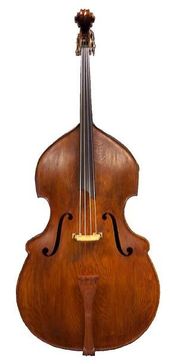 The double bass is a good string instrument to
learn, it's fun to play, and is versatile enough to be welcomed in many
different kinds of ensemble. Not only that, but good double bass players are
always in demand! The double bass is a good string instrument to
learn, it's fun to play, and is versatile enough to be welcomed in many
different kinds of ensemble. Not only that, but good double bass players are
always in demand!
The double bass looks a bit like
a giant violin, although it’s actually descended from an older form of
instrument called the viol. If you look at a violin and a double bass together,
you’ll see that the double bass has sloping shoulders instead of very round
shoulders like the violin or cello (although those rounded shoulders would
definitely get in the way if you tried to play a double bass that had them!). A
double bass has four thick steel strings tuned to E below the bass clef, then A,
D and G. The bow is different to the one used with a cello, too. It’s shorter
and heavier. Like a violin, though, you rub the rosined bow across the strings
to make the sound, and make different notes by stopping the strings against the
fingerboard with the fingers of your left hand.
The way the bow is used is also
different for bass players than for other string musicians. The bow is short and
heavy, and more attention is given to the "bite" of the bow (the way it digs
into the string, grips it and then releases it to start the note) rather than
the more gentle stroking motion of the other strings. Bassists also have to
pluck the strings (called "pizzicato") more often than other string players.
Double bass players can find themselves playing in all sorts of ensembles. They
are essential in orchestras, are used on the bass line in a wind band, and are
vital to traditional jazz bands. They can also be found in most other types of
jazz group, and are even used in folk and pop groups. The bass can be easily
amplified using a little microphone fixed to its woodwork.
It’s best to start double bass
lessons when you are at least 11 or 12 years old, although some people come to
the instrument quite late. Although the size of the instrument can seem
daunting, it is possible to get double basses in a number of sizes.
It’s common to start on a
reasonably easily managed 1/2 size bass, although there is actually a smaller
"mini-bass" available. A 3/4 size bass, on the other hand, should last the rest
of your educational life, and some players actually choose to stick with this
size bass rather than upgrading to a full-size bass, as these can be very big
and hard to manage. If you are very small you may find that you need a big stool
to help you reach the fingerboard comfortably.
Some people choose to stand behind or beside their bass while they play, rather
than using a stool, but most teachers don't like this as it can lead to an
awkward left hand shape which can inhibit the fingering action over time. If you
can play sitting on a tall stool with the instrument leaning between your legs,
then do so. You’ll also need to buy or make something to hold the instrument’s
spike to prevent it slipping or damaging the floor. And get yourself a good
stool straight away. An adjustable bar stool can be a good option while you are
growing. These have big wooden screw mechanisms and can be bought quite cheaply
from big furniture chains such as Ikea.
Double bass music is written in
the bass clef, like the left hand of the piano.
It’s possible to buy a new 1/2
or 3/4 size "student" quality double bass from about £500. But really good
instruments can cost thousands of pounds. In the mean time, it’s a good idea to
borrow or rent a bass while you work out just how much you love it!
The only real problem you might have with taking up the double bass is that it’s
not the easiest of instruments to carry about. You will need someone with a car
who is willing to help you transport it. A big car would be ideal, because
you’ll be carrying not just the bass but also your bow, stool and music, but a
double bass will also fit into a smaller car with patience and practice!
How is the Double Bass
tuned?
Most double basses today have
four strings and are tuned in fourths: E – A – D – G. The tuning in fourths
makes the double bass different from all other modern string instruments.
It was inevitable
that the interval between open strings would be smaller than on
other stringed instruments as the distance between notes on such a
large instrument is much greater. Sometimes there is a fifth string
on a double bass and this is tuned most commonly to B¢ and sometimes
C¢. This extra string which some conductors require in orchestras
means that every note the cello plays can be doubled an octave lower
on the double bass adding a great richness to the sonority of the
orchestra. Some double basses have a special lever that can lower
the E¢ string down to a C¢ when required.
Part of the reason for
the double bass’s tuning evolving in the way it did has to do with its
ancestry. The double bass’s ancestor was the violone which has
six strings, whose tuning in the early 17th century was D× – G – C – E –
A – D (though it should be noted that stating any tuning as standard for
the double bass at this time would be wrong as there were almost as many
tunings as instruments). In time the number of strings was halved
to three, and these three-stringed instruments could still be found in
the 18th century. They were tuned to A – D – G or G – D – G.
Double Bass Strings -
Gut, Wire Wound or Nylon - Covered?
Gut strings do
require a little maintenance, it is advisable to gently clip any "hairs"
(hair-like little strands of gut that that develop with play) and oil
them (walnut oil, most pure vegetable oils can do) for the longest life,
if you are in a dry climate or go through dry periods. But if you want
the sound of vintage, all-natural bass try Gut Strings. The
wound A/E set which has metal windings to achieve the mass necessary for
the lower notes without the larger diameter- they have been made this
way for centuries.
Nylon Double Bass
Strings provide the warm tone of gut double bass strings but strings are
unaffected by varying humidity or temperature.
Black
Tape Double Bass Strings are a great soft and playable double bass
string that is similar to gut double bass strings. they have a
strong bottom and response. These upright bass strings are in many ways
produced like the Labella Supernil strings but have a smoother wrap and
a closer feel to steel double bass strings. These double bass strings
are black nylon, tape wound with a rope core. Great for jazz pizzicato
solos, and combine gut string tone with metal string sustain.
The relative hardness
of the string's wrapping allows for a bigger growl, and although they
are primarily a jazz string, the surface of the wrapping makes it
particularly bow-friendly for a synthetic, they are the perfect medium
between gut strings and steel strings with strong fundamental and just
the right sustain. and perform very well in jazz, blues, bluegrass,
country, folk, and pizzicato double bass playing
Zoltan Dekany
Ron Mathewson
(born 19/02/44) Scotlands very own Jazz Double Bassist and
Electric Bassist from Lerwick in the Shetland Isles
Mathewson is best known for his years spent working with Ronnie
Scott, but has also done recordings with such artists as
Stan Getz,
Joe Henderson,
Ben Webster,
Philly Joe Jones,
Roy Eldridge,
Oscar Peterson and
Bill Evans. Mathewson was born into an unusually
musical household: at eight years old he was studying classical
piano.
Ron continued to study and perform classical piano until he
reached sixteen, having started playing bass guitar a year
earlier. (His talent was soon spotted -- and encouraged -- by
the legendary Shetland musician, 'Peerie' Willie Johnson.) In
1962 Mathewson was in Germany playing professionally with a
Scottish Dixieland band. In London
he also performed with various jazz and R&B bands
throughout the early 1960s. Around this time he was also a
member of
The Kenny Clarke-Francy Boland Big Band. In 1966
Mathewson became a member of the
Tubby Hayes band, with whom he performed with until 1973.
From 1975 on in to the 1990s, Ron was frequently a participant
in various Ronnie Scott recordings and concerts. In 1983,
he appeared on his old friend
Dick Morrissey's solo album
After Dark with
Jim Mullen,
John Critchinson,
Martin Drew and Barry Whitworth.
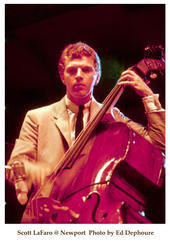 Rocco
Scott LaFaro (April 3, 1936, Newark, New
Jersey - July 6, 1961, Flint, New York) was one of the most influential jazz
bassists of the 20th century. Growing up in a musical family (his father played
in many big bands), LaFaro started on piano while in elementary school, began on
the bass clarinet in Junior High School, changing to tenor saxophone when he
entered High School. He only took up the double bass the summer before he
entered college, since learning a string instrument was required for music
majors. About three months into college, LaFaro decided to concentrate on bass. Rocco
Scott LaFaro (April 3, 1936, Newark, New
Jersey - July 6, 1961, Flint, New York) was one of the most influential jazz
bassists of the 20th century. Growing up in a musical family (his father played
in many big bands), LaFaro started on piano while in elementary school, began on
the bass clarinet in Junior High School, changing to tenor saxophone when he
entered High School. He only took up the double bass the summer before he
entered college, since learning a string instrument was required for music
majors. About three months into college, LaFaro decided to concentrate on bass.
He entered college to study music
but left during the early weeks of his Sophomore year, when he left to join
Buddy Morrow and his big band. He left that organization in Los Angeles after a
cross country tour and decided to try his luck in the Los Angeles music scene.
There, he quickly found work and became known as one of the best of the young
bassists. In 1959, after many gigs with such luminaries as Chet Baker, Percy
Heath, Victor Feldman Stan Kenton, and Benny Goodman, LaFaro hooked up with Bill
Evans, who had recently left the Miles Davis Sextet. It was with Evans and
drummer Paul Motian that LaFaro developed and expanded the counter-melodic style
that would come to characterize his playing. Ornette Coleman also used him
around this time.
LaFaro died in an automobile
accident in the summer of 1961 near Geneva, New York, his home town, two days
after accompanying Stan Getz at the Newport Jazz Festival. Although he performed
for only six years (1955-1961), his innovative approach to the bass redefined
jazz playing, and inspired a generation of bassists who followed him.
Dave Jones, - Bass
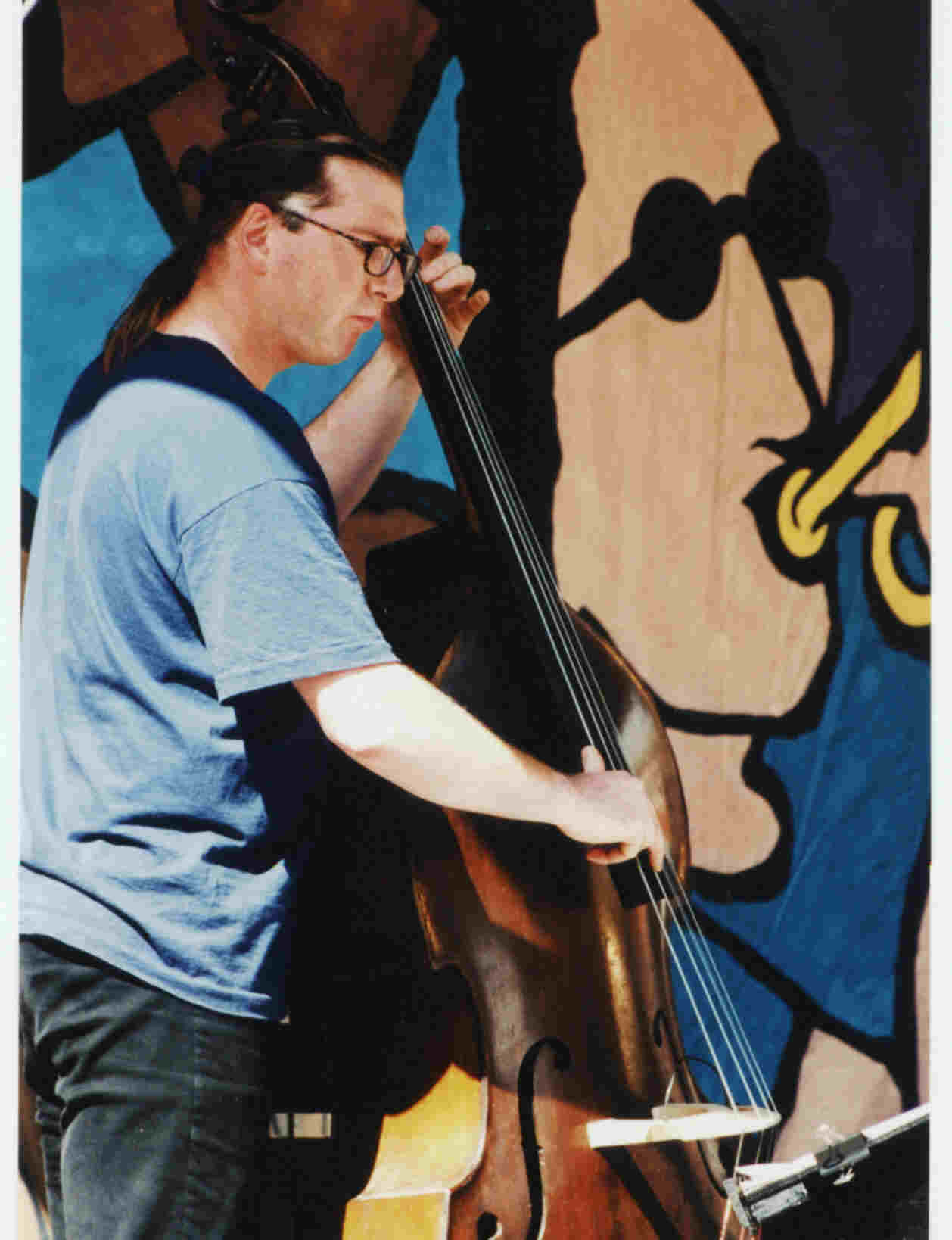 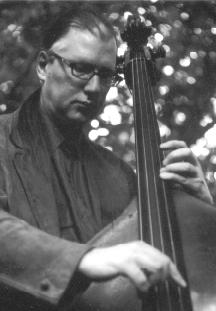 -
compositions / acoustic and electric basses -
compositions / acoustic and electric basses
After graduating from Newcastle College of Arts and Technology Dave toured and
recorded with Eurojazz , the European Community Youth Jazz Orchestra and since
then Dave's freelance playing has covered most aspects of performing and
recording both in the jazz and pop fields to theatre and television . Over the
last few years Dave has performed with The Steve Waterman Quartet , John
Etheridge , Carl Orr , Bobby Worth Quartet , Christian Garrick , Jacqui Hicks ,
Julian Stringle , Julian Siegal , Jim Mullen , Gilad Atzmon , Alison Bentley ,
Ingrid Laubrock , Janette Mason , Phil Robson , Bill Bruford , Dave O'Higgins
and David Gordon Trio etc .
He has performed with The Theo Travis Quartet and done many gigs with The BBC
Radio Big Band . He plays and records with
The Mick Foster Group featuring Jaqui Dankworth
,
The Pete Callard Quartet , Alison Bentley , and
has recorded two albums with
The Pete Cater Big Band which has won the big
band category in the P.O. British jazz awards . He has also played with visiting
American artists Harry Allen , Joe Temperley , Scott Hamilton , George Maseo ,
Peter Appleyard , Steve Hobbs , Marlene VerPlanck and Penelope Tobin. In
his former capacity as Director of Hackney Youth Jazz Orchestra , Dave
accompanied Wynton Marsalis while on a series of workshops and has since taught
at Brunel University , the London College of Music and
Richmond Adult and
Community College where he currently heads the music department while
teaching bass and taking a number of jazz workshops in the Saturday Jazz School.
Roy Babbington
Born : July 8th, 1940 - Kempton
(England)
Past Bands : Mike Gibbs Band, Keith Tippett Group, Delivery, Symbiosis,
Centipede, Ovary Lodge, Nucleus, Solid Gold Cadillac, Soft Machine, Barbara
Thompson's Jabula, Stan Tracey Groups...
Current Activity : jazz sessions & gigs
A professional jazz musician
since 1958 (!), Roy Babbington was very involved in the progressive music
movement, and the Canterbury scene in particular, between the late 60's and mid
70's, playing in bands like Delivery, Nucleus and Soft Machine, as well as many
informal jazz or jazz-rock ensembles. Taught himself the bass as a teenager, and
played clubs and ballrooms in his hometown until moving to London in 1969. He
soon joined the band Delivery, led by pianist Steve Miller and also including
guitarist Phil Miller, drummer Pip Pyle and sax player Lol Coxhill. With
Delivery, he regularly played upstairs at the famous Ronnie Scott's club,
getting to know the main exponents of the then-burgeoning London jazz scene.
Soon he started gigging with Mike Gibbs' and Keith Tippett's jazz bands at
Ronnie Scott's, and working extensively as a session musician. This in turn led
to guest appearances with Soft Machine - he played on the albums Fourth
(1971) and 5 (1972) - and gigs with saxophonist Gary Windo's occasional
band Symbiosis, and Tippett's 50-piece orchestra Centipede.
In May 1971, Delivery folded
after one album, A Fools Meeting (1970), recorded with (and credited to)
singer Carol Grimes. Babbington then joined Ian Carr's jazz-rock band
Nucleus, whose line-up at the time featured Karl Jenkins, John Marshall and Dave
MacRae. Unfortunately, his first year in Nucleus is not documented on disc, and
he is only featured on the albums Bella Donna (1972) - released as a solo
Ian Carr album - and Labyrinth (1973), none of which feature his future
Soft Machine colleagues. As a parallel to his activities with Nucleus, which
were interrupted during the first half of 1972 due to management problems,
Babbington also worked with Keith Tippett's Ovary Lodge and Mike Westbrook's
Solid Gold Cadillac. In May 1973, he left Nucleus and joined Soft Machine, which
now included his ex-Nucleus cohorts Jenkins and Marshall.
Joining Soft Machine was a
dramatic change for Babbington as he would from then on play almost
exclusively bass guitar, an instrument he'd long had prejudices against. In
spite of these initial misgivings, he turned out to be perfect for the job, and
stayed in the band for three albums - Seven (1973), Bundles (1975)
and Softs (1976) - and countless international tours. While in the band,
he continued to gig with visiting American jazz musicians and played for several
productions at the National Theater.
After leaving Soft Machine in
July 1976, Babbington resumed his former career as double bass player,
recording with Harry Beckett and Graham Collier among others, although he still
played electric music occasionally, notably with saxophonist Barbara Thompson's
jazz-rock groups Jubiaba and Paraphernalia, alongside Peter Lemer or Trevor
Tomkins. Since the early 80's, he has performed regularly with pianist Stan
Tracey in various configurations, and until recently with the BBC Radio
Orchestra.
Andy Cleyndert
His first professional experience was as
resident bassist at the George Chisolm Club in Manchester where he backed
visiting Jazz soloists including Americans such as Art Farmer and Joe Newman. On
moving to London in 1982 Andrew quickly established himself as a highly
versatile player, working with the cream of Uk and visiting musicians - Bobby
Wellins, Don Weller, Red Rodney, Bud Shank, Lee Konitz to name but a few. He
toured in the Caribbean, the Middle East and Europe with Ronnie Scott, and
Cananda and China with Stan Tracey Other tours include working with American
piano players Benny Green and most recently James Williams with drumming legend
Ed Thigpen, New York saxophonist Jon Gordon, trumpeter Conte Candoli, and
guitarists Herb Ellis and Mundel Lowe. He has released two albums as co-leader.
Andrew has taught on various summer schools including the Glamorgan Summer
School, The Jazz Academy at the Royal Academy and the Berkshire Jazz Weekend as
well as taking further study himself under double bass soloist Tony Haugham
Aidan O'Donnell
Aidan studied Jazz bass at Birmingham
Conservatoire from 1999-2003. After finishing his degree, he moved back to
Scotland where he joined both the Tommy Smith Quartet and the Colin Steele
Quintet. He moved to London in November 2003, where he joined Alan Skidmore's
Quartet, and began freelancing with a wide variety of musicians. He has
performed with visiting artists such as Dave Binney, Charles McPherson and David
Berkman, and appeared on 6 albums as a sideman
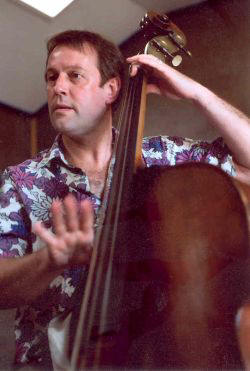 Steve
Kershaw
WWW.STEKPANNA.COM Steve
Kershaw
WWW.STEKPANNA.COM
“My Dad was a keen amateur musician who
played piano and trumpet. In fact he made a be-bop record in 1956 and ran a big
band up in Yorkshire until he died last year. So there was always jazz in the
house. My decision to go for the double bass came from seeing Ray Brown on a TV
programme: I was mesmerised by the sound of that fantastic beast of an
instrument and by his extraordinary hands, and from then on my mind was made up.
I later got to meet him in L.A. and to tell him that he was the reason that I
started playing: I got the impression that quite a lot of people had told him
the same thing! Nevertheless, it was fantastic to shake those wonderful hands.
Once my decision was made I borrowed a beaten up old bass from my school (my
teacher described it as a ‘sideboard’), and started on my musical adventures.”
Early influences and mentors?
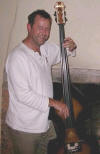
“I had
inspirational teachers, including Michael Calder, who was principal bass with
the Halle Orchestra, got myself into the British Youth Symphony Orchestra (great
for technique, reading, and meeting lovely girls!), and started playing in pit
orchestras (they gave you money, and if you memorised the music you could watch
lovely girls dancing). In Halifax in the 1970s you got your head kicked in if
you didn’t play Heavy Metal, so I got a bass guitar and learned to play louder
and faster than anyone else. I still remember playing the Princeville Rock Club
in Bradford where we performed in between two strippers on a Sunday lunchtime:
the audience threw glasses at you just to see if you were hard enough to stay on
the stage. I don’t think I’ve ever had stage fright since then!”
Steve Kershaw from is currently playing with
STEKPANNA,
Plaza Jazz Trio and Latin From The North latin jazz project. Mr. Kershaw
graduated from BIT (Bass Institute of Technology of Los Angeles) with Vocational
Honors; he received the Outstanding Vocational Honours Student awards from GHS
Strings: and he won the Outstanding Student of the Year award from Fender.
Raphael Mizraki
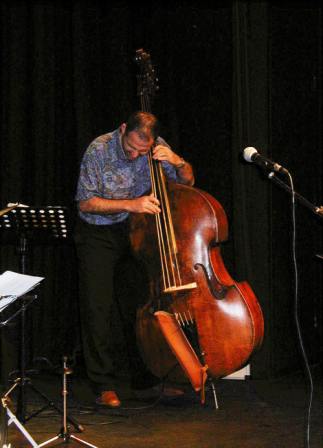 Raphael
Mizraki started working the age of fourteen as a professional jazz drummer and
pianist, despite being at the time mostly a cellist. During three years at York
University his interests became increasingly diverse, including school
workshops, ballet accompanying, jazz big bands, rock bands, Japanese drumming,
composing/arranging, touring theatre, and percussion in contemporary music. Raphael
Mizraki started working the age of fourteen as a professional jazz drummer and
pianist, despite being at the time mostly a cellist. During three years at York
University his interests became increasingly diverse, including school
workshops, ballet accompanying, jazz big bands, rock bands, Japanese drumming,
composing/arranging, touring theatre, and percussion in contemporary music.
For the last ten years his main instrument has been the electric bass, due to an
involvement in jazz, blues and soul music, though he is also frequently employed
on double bass and violone with some of London's leading early music ensembles
such as His Majesty's Sackbutts and Cornets and The Gabrieli Consort. As well as
regularly taking part in cross-cultural projects with African and Arabic
musicians, he tours extensively with Maddy Prior and the Carnival Band, and was
for several years a member of the Dufay Collective, in which he played oud,
rebec, viol and mediǽval percussion. Mr. Mizraki has performed with the Newberry
Consort on several occasions, including for tour concerts in Florence, Italy,
and Regensberg, Germany in 1995.
Raph is currently playing Electric & Upright
String basses for the Luis D'Agostino Trio
Alec
Dankworth
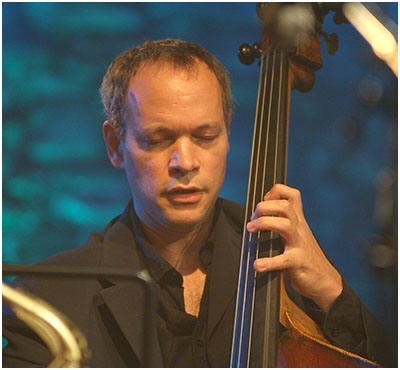
British Jazz Awards winner Alec
Dankworth has worked with artists as diverse as Stephanne Grappelli, Abdullah
Ibrahim and Van Morrison. After studying at Berklee Colledge of Music, Alec
became a member of various groups, notably Clark Tracey, Julian Joseph and Nigel
Kennedy. During a period of residency in New York he played with the Duke
Ellington Orchestra and joined the Dave Brubeck Quartet. Alec has since rejoined
his parents' group and leads the Alec Dankworth Trio. His recent recordings have
been with the Dave Brubeck Quartet, and the Bill Lesage Trio. In May 2001 Alec
left the Brubeck Quartet, and is based in London. He is now working once again
with John Dankworth and Cleo Laine, and with the Tina May Quartet. In 2002
The Alec Dankworth Trio was formed – an acoustic trio performing an eclectic
mixture of originals and standards by composers ranging from Dave Brubeck to
Abdullah Ibrahim. Featuring Phil Robson on guitar and Julian Arguelles on saxes.
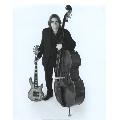 James
Eager James
Eager
 Paul
Morgan went to the Leeds College of Music
on a jazz course in 1976. From 1979 to 1982 he worked with the National
Youth Jazz Orchestra, and became the Principal Bass with the BBC Radio
Orchestra.Paul work has worked, and continues to work, with all types of groups
and big bands. He joined the Don Lusher Big Band in 1986 and continued to work
with this band up to Don's demise. He grew up accompanying many visiting
American and other international artists at Ronnie Scott’s Club, the Concorde
Club in Eastleigh, Southampton, and many clubs and concert halls around the
world. Paul has played bass for musicians such as Zoot Sims, Peggy Lee,
Ronnie Scott, and many other artists. Paul
Morgan went to the Leeds College of Music
on a jazz course in 1976. From 1979 to 1982 he worked with the National
Youth Jazz Orchestra, and became the Principal Bass with the BBC Radio
Orchestra.Paul work has worked, and continues to work, with all types of groups
and big bands. He joined the Don Lusher Big Band in 1986 and continued to work
with this band up to Don's demise. He grew up accompanying many visiting
American and other international artists at Ronnie Scott’s Club, the Concorde
Club in Eastleigh, Southampton, and many clubs and concert halls around the
world. Paul has played bass for musicians such as Zoot Sims, Peggy Lee,
Ronnie Scott, and many other artists.
Due to his phenomenal technique,
intonation, and sight reading ability, together with being equally adept whether
playing pizzicato or arco on the double bass, many of the illustrious artists
Paul has played with are not just in the jazz world. One of his main
influences is Niels Henning Orsted Pedersen, from Denmark, who also shares the
same kind of musical attributes as Paul does. Some recommendation, indeed!
Paul is now mainly active playing ‘straight’ orchestral double bass in film and
TV studios, as well as jazz gigs at Ronnie Scott’s Club, the various Pizza
Express establishments, the Bulls Head, Barnes, and other venues. He does
not teach formally but is always willing to help colleagues and students, who
have various problems playing the bass. Paul also plays with the New Jazz
Couriers
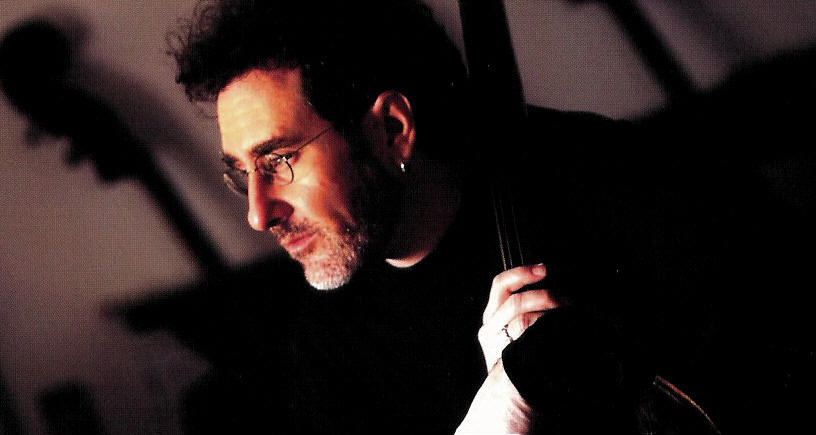 Brian
Bromberg From ages fourteen to
eighteen, Brian locked himself up in a room and practiced day and night. Testing
out of high school early and devoting all his time to music, for the next few
years Brian played every type of gig imaginable. Quite often Brian would play
five to seven nights a week with several different bands. Brian's first big
break came in 1979 when Marc Johnson, the wonderful bassist with the great jazz
pianist Bill Evans, heard Brian play. Several months later while on tour, Marc
ran into legendary jazz saxophonist Stan Getz. Stan was looking for a new bass
player and asked Marc if he knew any new young players. Marc told Stan about
Brian. Brian auditioned for Stan and joined the Stan Getz quintet in December of
1979. Brian had just turned 19 and spent nearly a year touring the world with
Stan and his band. Since then, Brian has toured, performed and or recorded with
some of the greatest artists of our time. Brian
Bromberg From ages fourteen to
eighteen, Brian locked himself up in a room and practiced day and night. Testing
out of high school early and devoting all his time to music, for the next few
years Brian played every type of gig imaginable. Quite often Brian would play
five to seven nights a week with several different bands. Brian's first big
break came in 1979 when Marc Johnson, the wonderful bassist with the great jazz
pianist Bill Evans, heard Brian play. Several months later while on tour, Marc
ran into legendary jazz saxophonist Stan Getz. Stan was looking for a new bass
player and asked Marc if he knew any new young players. Marc told Stan about
Brian. Brian auditioned for Stan and joined the Stan Getz quintet in December of
1979. Brian had just turned 19 and spent nearly a year touring the world with
Stan and his band. Since then, Brian has toured, performed and or recorded with
some of the greatest artists of our time.
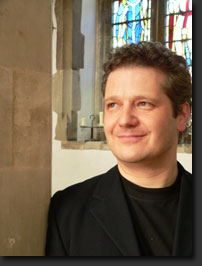 Malcolm
Creese Malcolm
Creese
is one of Europe's most admired double
bass players. He combines jazz and classical performances at the highest level
with extensive film, television and recording work. Malcolm is well known in the
jazz world for his melodic soloing and his rich un-amplified sound. He studied
cello at school and later at London's Guildhall School of Music. He worked as a
cellist in orchestras and chamber music groups after leaving college, but also
found time to pursue other areas of work including teaching, selling
instruments, managing a record shop and working for a music publishing company.
His love of jazz resulted in a switch to double bass in his mid-twenties.
 Ben
Bastin Ben
Bastin
Bass player Ben started playing music at age 9,
with the euphonium. He played with the Bedfordshire County Youth Concert
Band and the East Beds Concert Band. With these groups Ben was able to tour
in Germany, Belgium and Austria also appearing in the Edinburgh Festival and
in the Royal Albert Hall.
At around the age of 16 Ben started to play the electric bass after a few
years studying the guitar. This coincided with Ben's discovery of Jazz. Ben
joined the Bedfordshire Youth Jazz Orchestra on electric bass. Through this
Ben was able to again play at the royal Albert Hall supporting a band
featuring John Paricelli and Pete Churchill.
Ben moved to London in September 2004 and soon after began playing the
double bass under the tutelage of Dudley Philips and roy Babington. Ben now
studies at Middlesex University on the BA Jazz Course, and has also studied
at the Glamorgan Jazz Summer School. Ben plays regularly in and around
London playing music ranging from jazz standards to pop and funk to Ben's
own compositions. He has recently appeared with Gilad Atzmon and is now
fronting his own project under the "Ben Bastin Group"
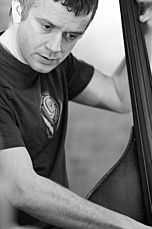
Arnie
Somogyi
–
One of the country’s finest bass players -
Arnie started off on violin at the
age of five. By the time he was 14 he was playing bass guitar. Five years later,
while studying for his English degree at Bristol University in the UK, he blew
his first grant cheque on a double bass and started playing with jazz drummer,
Tommy Chase, and Portishead's Adrian Utley. He's never quite recovered.
Arnie’s current band is “Ambulance”. and the sax player is the marvellous Paul
Booth.
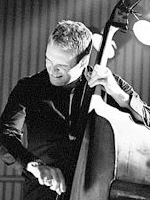 Mark
Hodgson - Born
in Kendal, Cumbria and coming from a musical family Mark originally played
electric bass in funk and fusion bands, but, aged eighteen, was inspired to take
up the double bass after seeing The Oscar Peterson Trio featuring Ray Brown. Mark
Hodgson - Born
in Kendal, Cumbria and coming from a musical family Mark originally played
electric bass in funk and fusion bands, but, aged eighteen, was inspired to take
up the double bass after seeing The Oscar Peterson Trio featuring Ray Brown.
In 1995 he moved to London to study Double Bass and Electric Bass at the
Guildhall School of Music and Drama.
In 1999 Mark left London and moved to Barcelona, Spain, where he was based for
four years.
He returned to the UK in 2003. Jazz artists Mark has worked with
include Cedar Walton, Phil Woods, Steve Grossman, Randy Brecker, Larry Coryell,
Kenny Wheeler, Bill Bruford and Greg Osby.
 Peter
Ind Studied Violin, then
Bass and Piano at Trinity College of Music London, turned professional 1946.
Whilst working as musician on RMS. Queen Mary, met and played with Lennie
Tristano Group in New York Emigrated to New York April 1951, performed and
recorded with many U.S. jazz musician's, including Lennie Tristano, Lee
Konitz, Warne Marsh, Paul Bley, Buddy Rich, and many others. Peter
Ind Studied Violin, then
Bass and Piano at Trinity College of Music London, turned professional 1946.
Whilst working as musician on RMS. Queen Mary, met and played with Lennie
Tristano Group in New York Emigrated to New York April 1951, performed and
recorded with many U.S. jazz musician's, including Lennie Tristano, Lee
Konitz, Warne Marsh, Paul Bley, Buddy Rich, and many others.
Frank
Hoefliger
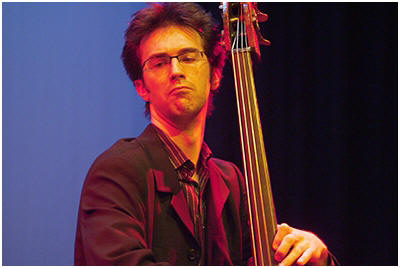 Peter
Billington Peter
Billington
Peter studied jazz at the Royal Academy of Music, and has an active presence
on the London jazz scene both as a pianist and double bassist, leading his
own trio and octet in addition to backing the likes of Peter King, Don
Weller, Henry Lowther, and Ben Castle. He has played at Ronnie Scotts, Pizza
Express Dean St. and the 606 club and at many other venues. Peter is an
accomplished composer, and his work can be heard on Clark Tracey's album
'The Calling'. Peter was musician in residence at Ardingly College
(2002-2003) and now teaches jazz piano at Eton. He regularly gigs as a trio
with Clark Tracey and Andy Crowdy.
Pete was a
member of Berkshire Youth Jazz Orchestra (Pendulum) & the National Youth
Jazz Orchestra, and was a member of the Scholarship Scheme at Berkshire
Young Musicians Trust. He plays piano, double-bass and viola, and has played
with dozens of UK
jazz musicians and recently toured Europe with Kid
Creole and the Coconuts. He’s currently working on a new album with Salena
Jones. If you know Pete you’ll know that he’s a brilliant musician in many
different spheres, and he’s a witty soloist
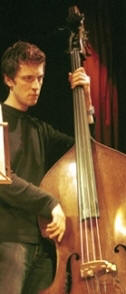 Phil
Donkin was born in Sunderland in
November 1980. He took up the electric bass at 12, playing in loud Rock bands
until moving to London in 1998, having previously developed an interest in jazz.
He studied at the prestigous Guildhall School of Music and Drama from '99 - '03,
taking up the double bass at the beginning of this course in '99, studying under
classical bassist, LSO principal Colin Paris. At the same time, Phil was playing
a lot of jazz and developing a great interest in bassists such as Charles Mingus,
Dave Holland and Larry Gales to name but a few. He became very interested in the
rhythmic concepts introduced by the Miles Davis Quintet from '63-'69 and later
developed by the bands of Dave Holland, Branford Marsalis, Steve Coleman etc. He
has also been influenced by freer concepts such as that of Albert Ayler, Ornette
Coleman and Cecil Taylor. Phil
Donkin was born in Sunderland in
November 1980. He took up the electric bass at 12, playing in loud Rock bands
until moving to London in 1998, having previously developed an interest in jazz.
He studied at the prestigous Guildhall School of Music and Drama from '99 - '03,
taking up the double bass at the beginning of this course in '99, studying under
classical bassist, LSO principal Colin Paris. At the same time, Phil was playing
a lot of jazz and developing a great interest in bassists such as Charles Mingus,
Dave Holland and Larry Gales to name but a few. He became very interested in the
rhythmic concepts introduced by the Miles Davis Quintet from '63-'69 and later
developed by the bands of Dave Holland, Branford Marsalis, Steve Coleman etc. He
has also been influenced by freer concepts such as that of Albert Ayler, Ornette
Coleman and Cecil Taylor.
Since 2002, Phil has been very busy on the London and UK scene, working with
British jazz legends Stan Sulzmann, Bobby Wellins, Jim Mullen, Martin Drew, Phil
Lee, Julian Arguelles, Martin France, Julian Joseph, Mark Mondesir, Steve
Williamson, Tim Garland, Nikki Illes, Tina May, Phil Robson, Julian Siegel, Paul
Clarvis, Hans Koller, amongst others. He has also worked with internationally
known artists such as Mike Gibbs, Kirk Lightsey, and Jeff Williams.
Phil has studied privately, and institutionally with Dave Liebman, Barry Harris,
Rufus Ried, Billy Cobham, John Pattitucci, Dave Friesen, Geoff Keezer, Drew
Gress, Ari Hoenig, Christian McBride.
- in his own words -
Hi, my name is Phil. I'm 26. I play the bass. I'm
from Sunderland ( North East England - Tired of explaining where it is - look on
a map for God's sake ).
I live in London where I play with other musicians
who like me - are trying to figure out what contribution we make to society. Of
these musicians are some great ones, such as - Gwilym Simcock, Ivo Neame, Martin
France, Graeme Blevins, Paul Booth, Julian Siegel, Gareth Lockrane, Blah Blah
Blah can't mention everyone.
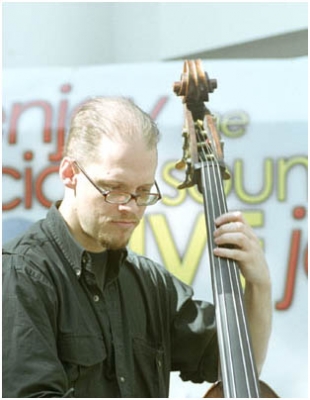 Nick
Kacal - Double Bass Nick
Kacal - Double Bass
After graduating from Salford University in 1990
with a degree in Electro-Acoustics, Nick Kacal worked as a free-lance
double-bassist, playing with a large and eclectic assortment of artists.
He has played with too many obscure jazz musicians to list; his interest in
other kinds of music has been assuaged by playing and recording with acts like
Dan Hicks and the Hot Licks,
Ado Matheson,
Songdog, TD
Lind, The Loose Cannons
Morag McLaren,
Zoey Schwartz
and John Etheridge.
He has played and toured in France, Germany, Cape Verde and all over the UK,
including Ronnie Scott's in London and festivals such as Womad, Brecon Jazz and
the Edinburgh Festival.
His own trio can be infrequently seen playing various jazz venues around the UK.
Currently he is working on a trio project with Dave Ohm and Grant Windsor .
Guerilla Sound
He can also frequently be seen
playing with piano pop powerhouse the
AT3..
.
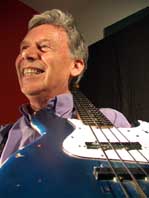 Herbie Flowers
Herbie Flowers
Herbie Flowers has had an enviable career in the
music business. He was a pop star in the early seventies, playing with the
likes of David Bowie and Marc Bolan. At one time his name was virtually
synonymous with the expression 'session musician' - if you wanted a bass
player you booked Herbie. As a result he has appeared on literally thousands
of hit recordings by artists as diverse as McCartney, Mancini, Sinatra and
the Scaffold. He is, perhaps, best known for his portamento bass-line on Lou
Reed's Walk on the Wild Side and for being one of the founder members of Sky
(along with John Williams). He has also played tuba with many of the world's
leading symphony orchestras. Most recently Herbie has appeared with
Jools Holland, Clannad and McCartney and is finding a new element to his
career as a raconteur, appearing with Mike Hatchard. Their recent appearance
at the Purcell Room with Selena Jones was a sell-out success
Julian Bury, a hard swinging, solid bassman who is in constant demand on
the London jazz scene.
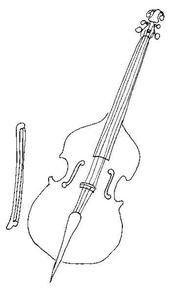
Double
Bass Player Page
http://www.basscentre.com/
http://www.overwaterbasses.com/
http://www.hearingprotection.co.uk/musicians-info.htm
http://www.seibass.com/
http://www.labella.com/
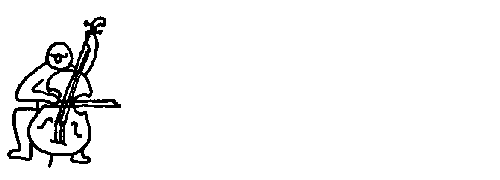
|
 Contrabass
or Double Bass
Contrabass
or Double Bass The double bass is a good string instrument to
learn, it's fun to play, and is versatile enough to be welcomed in many
different kinds of ensemble. Not only that, but good double bass players are
always in demand!
The double bass is a good string instrument to
learn, it's fun to play, and is versatile enough to be welcomed in many
different kinds of ensemble. Not only that, but good double bass players are
always in demand! Rocco
Scott LaFaro (April 3, 1936, Newark, New
Jersey - July 6, 1961, Flint, New York) was one of the most influential jazz
bassists of the 20th century. Growing up in a musical family (his father played
in many big bands), LaFaro started on piano while in elementary school, began on
the bass clarinet in Junior High School, changing to tenor saxophone when he
entered High School. He only took up the double bass the summer before he
entered college, since learning a string instrument was required for music
majors. About three months into college, LaFaro decided to concentrate on bass.
Rocco
Scott LaFaro (April 3, 1936, Newark, New
Jersey - July 6, 1961, Flint, New York) was one of the most influential jazz
bassists of the 20th century. Growing up in a musical family (his father played
in many big bands), LaFaro started on piano while in elementary school, began on
the bass clarinet in Junior High School, changing to tenor saxophone when he
entered High School. He only took up the double bass the summer before he
entered college, since learning a string instrument was required for music
majors. About three months into college, LaFaro decided to concentrate on bass.

 -
compositions / acoustic and electric basses
-
compositions / acoustic and electric basses Steve
Kershaw
Steve
Kershaw 
 Raphael
Mizraki started working the age of fourteen as a professional jazz drummer and
pianist, despite being at the time mostly a cellist. During three years at York
University his interests became increasingly diverse, including school
workshops, ballet accompanying, jazz big bands, rock bands, Japanese drumming,
composing/arranging, touring theatre, and percussion in contemporary music.
Raphael
Mizraki started working the age of fourteen as a professional jazz drummer and
pianist, despite being at the time mostly a cellist. During three years at York
University his interests became increasingly diverse, including school
workshops, ballet accompanying, jazz big bands, rock bands, Japanese drumming,
composing/arranging, touring theatre, and percussion in contemporary music.

 Paul
Morgan went to the Leeds College of Music
on a jazz course in 1976. From 1979 to 1982 he worked with the National
Youth Jazz Orchestra, and became the Principal Bass with the BBC Radio
Orchestra.Paul work has worked, and continues to work, with all types of groups
and big bands. He joined the Don Lusher Big Band in 1986 and continued to work
with this band up to Don's demise. He grew up accompanying many visiting
American and other international artists at Ronnie Scott’s Club, the Concorde
Club in Eastleigh, Southampton, and many clubs and concert halls around the
world. Paul has played bass for musicians such as Zoot Sims, Peggy Lee,
Ronnie Scott, and many other artists.
Paul
Morgan went to the Leeds College of Music
on a jazz course in 1976. From 1979 to 1982 he worked with the National
Youth Jazz Orchestra, and became the Principal Bass with the BBC Radio
Orchestra.Paul work has worked, and continues to work, with all types of groups
and big bands. He joined the Don Lusher Big Band in 1986 and continued to work
with this band up to Don's demise. He grew up accompanying many visiting
American and other international artists at Ronnie Scott’s Club, the Concorde
Club in Eastleigh, Southampton, and many clubs and concert halls around the
world. Paul has played bass for musicians such as Zoot Sims, Peggy Lee,
Ronnie Scott, and many other artists. 
 Malcolm
Creese
Malcolm
Creese


 Peter
Ind
Peter
Ind Peter
Billington
Peter
Billington
 Nick
Kacal - Double Bass
Nick
Kacal - Double Bass Herbie Flowers
Herbie Flowers
